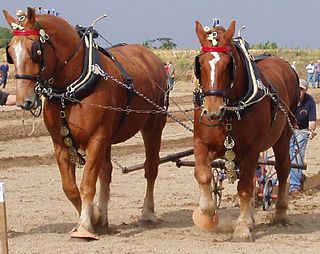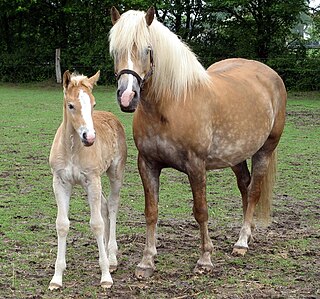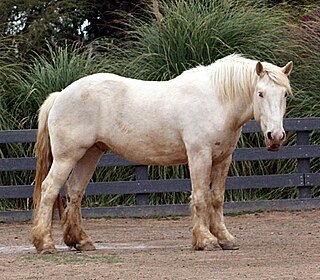
The Mangalarga Marchador is a Brazilian breed of riding horse. It is the national horse breed of Brazil, where there are more than half a million of them; it is among the most numerous breeds of riding horse in the world. It derives from cross-breeding of Portuguese Alter Real horses with local Criollo stock. It displays four gaits: the walk, the canter, and two ambling gaits, the marcha batida and the marcha picada; it does not trot.

The Morgan horse is one of the earliest horse breeds developed in the United States. Tracing back to the foundation sire Figure, later named Justin Morgan after his best-known owner, as well as mares of the now-extinct Narragansett Pacer breed, Morgans served many roles in 19th-century American history, being used as coach horses and for harness racing, as general riding animals, and as cavalry horses during the American Civil War on both sides of the conflict. Morgans have influenced other major American breeds, including the American Quarter Horse, the American Saddlebred, the Tennessee Walking Horse, and the Standardbred.

The Percheron is a breed of draft horse that originated in the Huisne river valley in western France, part of the former Perche province, from which the breed takes its name. Usually gray or black in color, Percherons are well-muscled, and known for their intelligence and willingness to work. Although their exact origins are unknown, the ancestors of the breed were present in the valley by the 17th century. They are believed to descend from war horses. Over time, they began to be used for pulling stagecoaches; and later, for agriculture and hauling heavy goods. In the late 18th and early 19th centuries, Arabian blood was added to the breed. Exports of Percherons from France rose exponentially in the late 19th century, and the first purely Percheron stud book was created in France in 1893.

The Suffolk Horse, also historically known as the Suffolk Punch or Suffolk Sorrel, is an English breed of draught horse. The first part of the name is from the county of Suffolk in East Anglia, and the word "Punch" is an old English word for a short stout person. It is a heavy draught horse which is always chestnut in colour, traditionally spelled "chesnut". Suffolk Punches are known as good doers, and tend to have energetic gaits.

The Cleveland Bay is a breed of horse that originated in England during the 17th century, named after its colouring and the Cleveland district of Yorkshire. It is a well-muscled horse, with legs that are strong but short in relation to the body. The horses are always bay in colour, although a few light hairs in the mane and tail are characteristic of some breed lines. It is the oldest established horse breed in England. The ancestors of the breed were developed during the Middle Ages for use as pack horses, when they gained their nickname of "Chapman Horses". These pack horses were cross-bred with Andalusian and Barb blood, and later with Arabians and Thoroughbreds, to create the Cleveland Bay of today. Over the years, the breed became lighter in frame as they were employed more as carriage and riding horses. The popularity of the Cleveland Bay has greatly fluctuated since it was first imported to the United States in the early nineteenth century. Despite serious declines in the population after the Second World War, the breed has experienced a resurgence in popularity since the 1970s, although only around 550 horses existed worldwide as of 2006.

The Lusitano, also known as the Pure Blood Lusitano or PSL, is a Portuguese horse breed. Horses were known to be present on the Iberian Peninsula as far back as 20,000 BC, and by 800 BC the region was renowned for its war horses. The fame of the horses from Lusitania goes back to the Roman Age, which attributed its speed to the influence of the West wind, who was considered capable of fertilizing the mares. When the Muslims invaded Iberia in 711 AD, they brought Arabian horses with them that were crossed with the native horses, developing a horse that became useful for war, dressage and bull fighting. The Portuguese horse was named the Lusitano, after the word Lusitania, the ancient Roman name for the region that modern Portugal occupies. There are four main breed lineages within the breed today, and characteristics differ slightly between each line.

The Narragansett Pacer was one of the first recorded horse breeds developed in the United States. It emerged in the 18th century (1700s), and was theorized to have been bred from a mix of English and Spanish breeds, although the exact cross is unknown. The Pacer was associated with, and bred in, the state of Rhode Island and the area of New England; as horse breeding shifted to Kentucky and Tennessee in the late 1700s, it became extinct by the 20th century.

The Canadian is a horse breed from Canada. It is a strong, well-muscled horse, usually dark in colour. It is generally used for riding and driving. Descended from draft and light riding horses imported to Canada in the late 1600s from France, it was later crossed with other British and American breeds. During the 18th century the Canadian horse spread throughout the northeastern US, where it contributed to the development of several horse breeds. During the peak popularity of the breed, three subtypes could be distinguished, a draft horse type, a trotting type and a pacing type. Thousands of horses were exported in the 19th century, many of whom were subsequently killed while acting as cavalry horses in the American Civil War. These exports decreased the purebred Canadian population almost to the point of extinction, prompting the formation of a studbook and the passage of a law against further export.

The Pony of the Americas is a pony breed developed in the state of Iowa in the United States. The foundation stallion was an Arabian/Appaloosa/Shetland pony cross. A breed registry was founded in 1954, and within 15 years had registered 12,500 ponies. Today, the Pony of the Americas Club is one of the largest and most active youth-oriented horse breed registries in the US. Although called ponies, POAs have the phenotype of a small horse, combining mainly Arabian and American Quarter Horse attributes. The registry is open, allowing blood from many other breeds, but has strict criteria for entry, including Appaloosa coloration, specified height and other physical characteristics. Although mainly bred for Western riding, the breed has been used for many other disciplines, including driving, endurance riding and some English disciplines.

The Criollo, or Crioulo, is the native horse of the Pampas with a reputation for long-distance endurance linked to a low basal metabolism. The breed, known for its hardiness and stamina, is popular in its home countries.

The Dole Gudbrandsdal, Dølahest, or Dole is a draft- and harness-type horse from Norway. The Dole Trotter is alternately considered a subtype of the Dole Gudbrandsdal and a separate breed; it is also considered a part of the coldblood trotter type. The Dole Gudbrandsdal is a small draft horse, known for its pulling power and agility, while the Dole Trotter is a smaller, faster horse used for harness racing; the two types are commonly interbred. Both types are strictly critiqued before entry into the studbook, which has over time resulted in an improvement in the breed type. The Dole is originally from the Gudbrandsdal Valley, and is probably descended in part from the Friesian horse. Over time, the breed has had Thoroughbred, Arabian, and other breeds added in, especially during the creation of the Dole Trotter in the 19th century. The first studbook was created in 1941, and the current breed association was formed in 1947. Although originally used mainly as a pack horse, today, the heavier Dole type is used mainly for agricultural purposes. The Dole Gudbrandsdal been crossed with other breeds to develop horses for harness racing and riding.
The Welara is a part-Arabian pony breed developed from the Arabian horse and the Welsh pony. It was originally bred in England by Lady Wentworth at the Crabbet Arabian Stud in the early 1900s from imported Arabian stallions and Welsh pony mares. Breeding then spread throughout North America. In 1981, a breed registry was formed in the United States, and a studbook began to be published. They are used for many disciplines of English riding, and are known for their refinement, hardiness and spirit.

The Haflinger, also known as the Avelignese, is a breed of horse developed in Austria and northern Italy during the late 19th century. Haflinger horses are relatively small, are always chestnut with flaxen mane and tail, have distinctive gaits described as energetic but smooth, and are well-muscled yet elegant. The breed traces its ancestry to the Middle Ages; several theories for its origin exist. Haflingers, developed for use in mountainous terrain, are known for their hardiness. Their current conformation and appearance are the result of infusions of bloodlines from Arabian and various European breeds into the original native Tyrolean ponies. The foundation sire, 249 Folie, was born in 1874; by 1904, the first breeders' cooperative was formed. All Haflingers can trace their lineage back to Folie through one of seven bloodlines. World Wars I and II, as well as the Great Depression, had a detrimental effect on the breed, and lower-quality animals were used at times to save the breed from extinction. During World War II, breeders focused on horses that were shorter and more draft-like, favored by the military for use as packhorses. The emphasis after the war shifted toward animals of increased refinement and height.

The Camargue horse is an ancient breed of horse indigenous to the Camargue area in southern France. Its origins remain relatively unknown, although it is generally considered one of the oldest breeds of horses in the world. For centuries, possibly thousands of years, these small horses have lived wild in the harsh environment of the Camargue marshes and wetlands of the Rhône delta, which covers part of the départements of Gard and Bouches-du-Rhône. There they developed the stamina, hardiness and agility for which they are known today. Traditionally, they live in semi-feral conditions in the marshy land of the region. The Camargue horse is the traditional mount of the gardians, the Camargue "cowboys" who herd the black Camargue bulls used for "courses camarguaises" in southern France. Camargue horses galloping through water is a popular and romantic image of the region.
The Lokai, a mountain horse bred in Tajikistan, is used as a riding horse, a packhorse, or even sometimes a light draft horse. Although small, the breed is agile and hardy. The breed was developed by crossing native mountain horses with a mixture of Central Asian and European bloodlines.

The American Cream Draft is an American breed of draft horse, characterized by the cream or "gold champagne" color of its coat. It was developed in Iowa during the early twentieth century from a cream-colored mare named Old Granny. A breed registry was formed in 1944 but became inactive for several decades when breed numbers dropped due to the mechanization of farming. It was reactivated in 1982 and population numbers have slowly grown since then. It is a rare breed: its conservation status is considered critical by The Livestock Conservancy and the Equus Survival Trust.
The Andravida or Eleia Horse is a light draft breed found in the region of Ilia in Greece. It owes its development to the crossing of Anglo-Norman with local breeds with additional crosses of Nonius stallions after 1920. The breed is close to extinction and its stud book was only established in 1995.

The Kazakh Horse is a horse breed of the Kazakh people, who live mainly in Kazakhstan, but also in parts of China, Mongolia, Russia and Uzbekistan. It is used mainly as a riding horse, and is known for its hardiness and stamina.

The Campolina horse breed of Brazil is named after Cassiano Campolina, the farmer who developed the breed. Beginning in 1870, they were developed using several different breeds of horses. The Campolina is one of the larger Brazilian breeds, and may be found in most colors. They are a gaited breed, with an ambling gait. They are used mainly for leisure riding and driving and are increasingly used for dressage within Brazil.

Hirzai or Nukra is a rare breed of riding horse originating from Pakistan. These horses are of Arab origin and have ample resemblance to Baluchis. Their size is intermediate between those of a horse and a pony. Thoroughbred stallions provided by the Balochistan Government at important centers such as Quetta and Sibi are instrumental in large scale crossbreeding with native mares. The objective is to improve the native stock, however, this policy has led to the deterioration of native breeds purity. Good specimens of Balochi and Hirzai breeds are available at Sibi and Nasirabad Horse shows. These horses are found in all provinces of Pakistan.

















